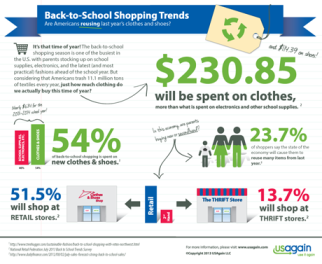 Today is Aug. 1, and for students, the days of summer are officially numbered. Slowly, the days will become colder and shorter, and before long, school buses will resume shuttling students to and from school. Before that, however, there will be lots and lots of back-to-school shopping.
Today is Aug. 1, and for students, the days of summer are officially numbered. Slowly, the days will become colder and shorter, and before long, school buses will resume shuttling students to and from school. Before that, however, there will be lots and lots of back-to-school shopping.
Restocking on school supplies, tech gear, clothing and shoes is an annual process for parents and students of all ages. As with almost any type of shopping, you can make your back-to-school shopping eco-friendly with a little bit of extra effort and creativity.
Take Inventory
Perhaps the simplest way to green your back-to-school shopping is to limit what you buy. Sure, it’s easy to head out to a store and buy a cart full of new folders, notebooks and pencils, but you should always check what you’ve currently got before buying new. Clothes and shoes might go out of style, but school supplies certainly don’t. According to the National Retail Federation, the average family will spend $634.78 on back-to-school shopping. While that number is down slightly from last year’s $688.62, it can drop even further if you use leftover supplies from 2012.
Consider an Eco-Friendly Backpack
Traditionally manufactured backpacks are made with large amounts of plastics and metals—not exactly eco-friendly materials. Fortunately for the green shopper, there’s a good selection of eco-friendly backpacks made from recycled materials, and going by Ecouterre’s guide, they still manage to pack some style. Recycled backpacks give a second life to post-consumer cotton, seat belts and air bags, giving them an A+ for creative recycling in our book.
Carpool, Walk or Ride to School
According to the EPA, transportation accounts for 28 percent of all emissions. Combine that with the fact that school buses in the U.S. travel four billion miles each year, there’s a real need to reduce transportation to and from school. Walking or riding a bike to school are the greenest alternatives, but those aren’t options for students who live far from school. Riding the bus is a better option than driving in separate cars, especially if your school’s bus fleet follows the EPA’s Clean School Bus campaign. If buses don’t serve your area, arrange a carpool program with neighbors; it’ll reduce emissions and the amount you spend at the pump.
Recycle Leftover Clothes
When buying new clothing and shoes for the new school year—most students’ favorite part of back-to-school shopping—make sure to responsibly dispose of surplus clothes and only buy what’s absolutely necessary. A USAgain recycling bin in your area will do the trick, and depending on the condition of your clothes, the stuff you deposit in the bin could become the pride and joy of someone else’s wardrobe for the new school year.
With a few small steps, back-to-school shopping can be an environmentally responsible act of consumerism. As you browse the aisles for school supplies and clothing, don’t forget the environment as you add to your cart.
Pingback: Back-to-School the Eco-Friendly Way « USAgain Seattle
Pingback: Back-to-School the Eco-Friendly Way « USAgain San Francisco
Pingback: Back-to-School the Eco-Friendly Way « USAgain Southern California
Pingback: Back-to-School the Eco-Friendly Way « USAgain Wilkes-Barre
Pingback: Back-to-School the Eco-Friendly Way « USAgain Milwaukee
Pingback: Back-to-School the Eco-Friendly Way « USAgain Denver